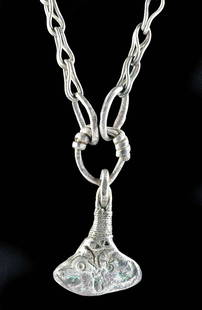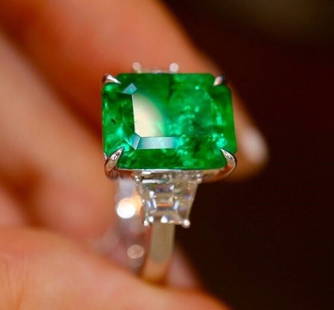
10th C. Viking Silver Necklace w/ Thor's Hammer Pendant
Similar Sale History
View More Items in Necklaces & PendantsRelated Necklaces & Pendants
More Items in Necklaces & Pendants
View MoreRecommended Jewelry
View More





Item Details
Description
Northern Europe, Scandinavia, Viking or Norse culture, ca. 10th century CE. An incredibly long, knitted chain made from 97% to 97.5% silver wire ending in a pair of terminals wrapped in twisted silver wire. Dangling from a loop ring on the chain terminals is a slender 82% to 85% silver pendant depicting Mjolnir, Thor's legendary hammer, the head wrapped in silver cord and decorated with impressed triangular and radiating linear motifs. Size (pendant): 0.83" W x 1.77" H (2.1 cm x 4.5 cm); (chain): 34.5" L (87.6 cm); silver quality: 97% to 97.5% for chain, 82% to 85% for pendant; total weight: 40.3 grams
Small Thor's hammers were worn as religious amulets throughout the Viking era, usually made of silver and usually hung on silver chains. Some even made it to the Christian era; there is a famous example of a Thor's hammer amulet from Fossi, Iceland, that has been turned into a cross (they are also invoked nowadays to describe the power of the surprisingly mighty Icelandic football team). The chain itself, meanwhile, is a style of loose knitwork done with thin silver wire that seems to have originated with the Vikings.
The important Viking metalworking shops correspond to their great trading ports and proto-urban centers - Birka, Helgo, Sigtuna, and Lund in Sweden, Ribe, Haithabu (Hedeby), and Fyrkat in Denmark, and Kaupang and Trondheim in Norway. Silver was the principal currency of the Viking world, which stretched from Russia to northern Canada at the height of their influence. In many places, the Vikings kept silver not as coins, but as jewelry, a wearable currency form that was not subject to the authority of a monarch or mint. One of the most common archaeological finds from the Viking period is a hoard of metal objects, often buried in the earth or deposited in bodies of water, like riverbeds. These are found in great quantities throughout the British Isles and the Nordic countries. What was the meaning of such hoards? Were they treasures buried for safe keeping, perhaps by people fleeing violence who did not wish to travel with heavy loads and who died or forgot before they could retrieve them? Or does their presence in rivers suggest votive deposits, gifts and offerings to spirits who lived in the water?
Provenance: private New York, New York, USA collection; ex-private Kaliningrad (Koenigsberg) and then Latvia collection; found on the Baltic Sea coast prior to 1982
All items legal to buy/sell under U.S. Statute covering cultural patrimony Code 2600, CHAPTER 14, and are guaranteed to be as described or your money back.
A Certificate of Authenticity will accompany all winning bids.
We ship worldwide to most countries and handle all shipping in-house for your convenience.
#175642
Small Thor's hammers were worn as religious amulets throughout the Viking era, usually made of silver and usually hung on silver chains. Some even made it to the Christian era; there is a famous example of a Thor's hammer amulet from Fossi, Iceland, that has been turned into a cross (they are also invoked nowadays to describe the power of the surprisingly mighty Icelandic football team). The chain itself, meanwhile, is a style of loose knitwork done with thin silver wire that seems to have originated with the Vikings.
The important Viking metalworking shops correspond to their great trading ports and proto-urban centers - Birka, Helgo, Sigtuna, and Lund in Sweden, Ribe, Haithabu (Hedeby), and Fyrkat in Denmark, and Kaupang and Trondheim in Norway. Silver was the principal currency of the Viking world, which stretched from Russia to northern Canada at the height of their influence. In many places, the Vikings kept silver not as coins, but as jewelry, a wearable currency form that was not subject to the authority of a monarch or mint. One of the most common archaeological finds from the Viking period is a hoard of metal objects, often buried in the earth or deposited in bodies of water, like riverbeds. These are found in great quantities throughout the British Isles and the Nordic countries. What was the meaning of such hoards? Were they treasures buried for safe keeping, perhaps by people fleeing violence who did not wish to travel with heavy loads and who died or forgot before they could retrieve them? Or does their presence in rivers suggest votive deposits, gifts and offerings to spirits who lived in the water?
Provenance: private New York, New York, USA collection; ex-private Kaliningrad (Koenigsberg) and then Latvia collection; found on the Baltic Sea coast prior to 1982
All items legal to buy/sell under U.S. Statute covering cultural patrimony Code 2600, CHAPTER 14, and are guaranteed to be as described or your money back.
A Certificate of Authenticity will accompany all winning bids.
We ship worldwide to most countries and handle all shipping in-house for your convenience.
#175642
Condition
Professional cleaning to chain links and hammer pendant, with light abrasions and earthen deposits, otherwise intact and excellent. Great preservation to stamped motifs on hammer pendant and nice patina throughout.
Buyer's Premium
- 26.5%
10th C. Viking Silver Necklace w/ Thor's Hammer Pendant
Estimate $7,000 - $10,500
11 bidders are watching this item.
Shipping & Pickup Options
Item located in Louisville, CO, usSee Policy for Shipping
Payment

TOP














































































